“Freedom is never more than one generation away from extinction.
We didn’t pass it on to our children in the bloodstream.
It must be fought for, protected,
and handed on for them to do the same,
or one day we will spend our sunset years telling our children
what it was once like in the United States when men were free.”
— Ronald Reagan
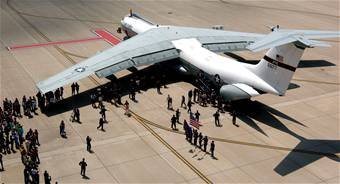
Click to see VIDEO
Families swarm to greet former prisoners of war moments after they landed in the C-141 “Hanoi Taxi” on Friday, May 5, 2006, at the National Museum of the United States Air Force in Dayton, Ohio. The “Hanoi Taxi” was the first aircraft to arrive in Hanoi in February 1973 to pick up POWs returning to the United States. (U.S. Air Force photo/Tech. Sgt. Larry A. Simmons)
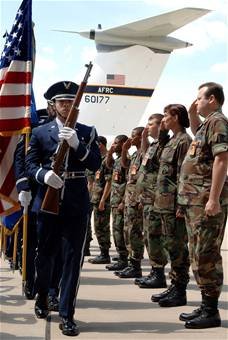
Airman 1st Class Humberto Alcocer leads the honor guard during a ceremony recognizing the last mission of the C-141 “Hanoi Taxi” on Friday, May 5, 2006, at the National Museum of the United States Air Force in Dayton, Ohio. Airman Alcocer is a member of the Wright-Patterson Air Force Base honor guard, and is with the 88th Medical Operations Squadron. (U.S. Air Force photo/Tech. Sgt. Larry A. Simmons
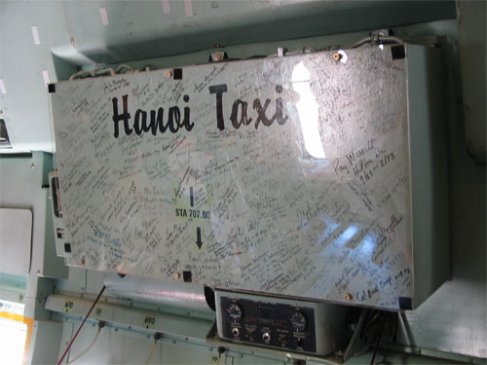
While walking through it you see the equipment box that the POW’s signed as they flew back home.
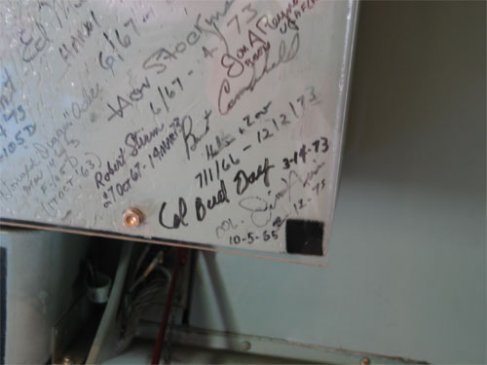
Note in the corner the signature of Col. George “Bud” Day – Medal of Honor winner and outspoken critic of John Kerry He was a POW in North Vietnam, 1967-1973.
For more than five years, Col.Bud Day resisted the North Vietnamese guards who tortured him. On one occasion in 1971, when guards burst in with rifles as some of the American prisoners gathered for a forbidden religious service, Major Day stood up, looked down the muzzles of the guns, and began to sing “The Star-Spangled Banner.” The other men, including James Stockdale, the ranking U.S. officer in the prison, joined him.
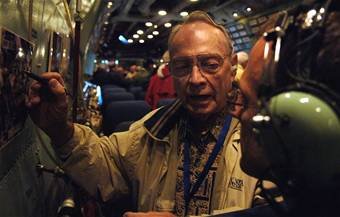
Jim Lamar (left) talks to Tech. Sgt. Rick Sforza on Saturday, May 6, 2006, about an aerial photograph of the “Hanoi Hilton” prisoner of war camp where he was held captive in Vietnam. The two men were flying on the final mission of the C-141 “Hanoi Taxi” over Wright-Patterson Air Force Base, Ohio. Sergeant Sforza is a Reserve photographer with the 4th Combat Camera Squadron. (U.S. Air Force photo/Tech. Sgt. Larry A. Simmons)
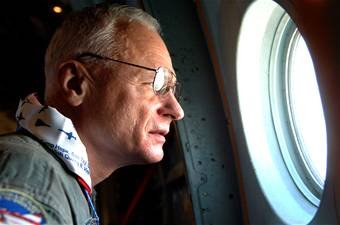
Col. Doug Moe looks out the window while flying on one of the the last missions of the C-141 “Hanoi Taxi” on Friday, May 5, 2006 over Wright-Patterson Air Force Base, Ohio. The “Hanoi Taxi” was the first aircraft to arrive in Hanoi in February 1973 to pick up prisoners of war returning to the United States. The C-141 landed at the National Museum of the United States Air Force where it will be on display this summer. (U.S. Air Force photo/Tech. Sgt. Larry A. Simmons)
DAYTON, Ohio (AFPN) — The first aircraft to return Vietnam prisoners of war to the United States arrived at the National Museum of the United States Air Force at 9:30 a.m. May 6.
The C-141 “Hanoi Taxi” was the first aircraft to arrive in Hanoi in February 1973 to pick up POWs returning to the United States. The “Hanoi Taxi” was one of several aircraft involved in repatriating more than 500 American POWs held by the North Vietnamese.
The Hanoi Taxi — the last C-141 Starlifter still serving in the Air Force — made two of its final three flights May 5. Former POWs gathered for a reunion and to take part in a weekend of activities created by the Air Force Reserve Command’s 445th Airlift Wing here that included retirement of the famed aircraft.
The aircraft made several passes before its final landing on the runway behind the museum May 6. Crewmembers from the 445th AW flew the aircraft from nearby Wright-Patterson Air Force Base to the museum.
A ceremony was held following the aircraft’s arrival at the museum. Speakers included Gen. Duncan J. McNabb, commander of Air Mobility Command; Lt. Gen. John A. Bradley, commander of Air Force Reserve Command; and retired Maj. Gen. Charles D. Metcalf, museum director. Former Vietnam POWs and past crewmembers were in attendance to witness the event.
During the ceremony, Lockheed Martin presented the museum with a painting of the Hanoi Taxi flying over the museum. The painting is titled “The Airlift Legend: Celebrating the 43-Year Career of the C-141 Starlifter.”
Herv Stockman – flew more than 50 combat missions during WWII piloting a P51. Flew the first U-2 mission over the Soviet Union. Watched Migs scramble in futility, two colliding, and follow helplessly, far below.
Speaking before the public about his Hanoi captivity:
The last of the morning’s speakers was Hervey Stockman, a fighter pilot who saw action in all our hot and cold wars: World War II, Korea, the first U2 flight over the Soviet Union, and Vietnam, where his plane crashed and he spent six years in a sevenbysevenfoot prison cell in Hanoi. He had been reluctant to talk about that ordeal as a prisoner of war, but the class officers asked him to try, feeling that in his character and his generous heart he represented the best of what the class set out so long ago to be.
“Preparing these words was much like visiting an old, untended graveyard,” Hervey Stockman said, looking out at us from the lectern, a trim man with a warm smile. He began by describing the brutal treatment he received in the early months of his imprisonment — “I was a foul, decrepit wreck of a man” — and then recalled the slow process by which at last “my mind was awakened and reunited to my body and I had the will to live and regain my strength.” He spoke slowly, barely controlling his emotions, but without selfpity, and when he walked back to his seat, his slightly stiff gait betraying his long captivity, the class rose in an ovation that had no relation to the applause usually heard at the end of a speech: mere handclapping. It had tremendous solemnity — it was emotional without being sentimental — and it rumbled through the auditorium.
Robert Lewis Stirm
I was shot down over Hanoi 27 October 1967 while leading a flight of F-105Ds on Canal Des Rapides Bridge. They captured me immediately on landing and I was displayed in Hanoi that night. I was detained in various cells of five different POW camps and was in solitary confinement a total of 281 days. They turned me over to US control on 14 March 1973.
I never once lost faith in our government, our President, or my family.
The museum plans for the Hanoi Taxi to be on public display this summer.
Wild Thing’s comment…………
If our government would have done what John F’n Kerry recommended when he came back from Paris after consorting with the enemy, everyone of those names would have belonged to a dead man! Kerry said we should immediately abandon South East Asia, and pay whatever damages North Vietnam decided we owed them.
my POW MIA page
my Vietnam page
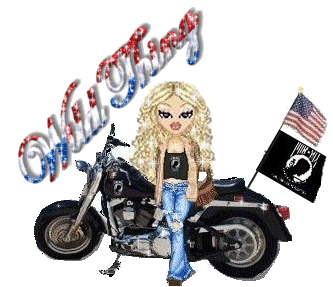
My other post announcing C-141 “Hanoi Taxi” is Retiring
In that post there are also comments of one that flew this plane and others that shared their experiences.

* Argghhh
* Mudville Gazette

Thanks dear. God what powerful memories. I remember landing in Danang on the C141, the stench and oppressive heat when the cargo doors opened as we were hustled off and into the buses with screens on the windows to start the year’s adventure. Then again when that freedom bird landed at Chu Lai amongst a rocket attack to haul my grateful ass out of there, and the wonderful feeling of feet wet as we hit international airspace. I can only imagine what those wonderful POW’s felt on their freedom flight and I’m grateful that they received a better welcome than we did. God bless them all!!!
Jack with all my heart thank you for serving our country. Thank you for sharing about the C-141.
With proper leadership, no American should languish for years in POW camps. What happened in Vietnam was criminal on our leaderships’ part.
If only the politicians were forced to partake in several firefights I would guessour wars would end sooner and with decisive victories.
The C-141 was a good aircraft, but as a paratrooper I hated that jet blast. I preferred to exit prop aircraft, easier opening shock.
Tom I agree about leadership and politicians.
I love that you were a paratrooper.
TomR:
I noticed your post about the Engineers, and your comment here that you were a paratrooper. The 37th Engineers are Airborne (and some Air Assault, if they can get into the school), generally attached to the 82nd but now hanging out with the 10th Mountain in Afghanistan.
And you’re on target with the firefight comment, and the way wars grind on when they’re managed by men who never spent time on the ground, or who are obssessed by public opinion.
Jack & Tom…Man, you guys. Jeez…
…Thanks again. I keep saying that but WTF…I dunno what else to say.
TomR, as a former aircraft mechanic I have to say there is something wrong with people who jump out of perfectly good aircraft. I fixed them so people wouldn’t have to bail out. I keep telling my son that as he is going sky diving for the first time soon.
The C-141 was a good aircraft. I worked the “A” models which was before they stretched them. They were an overpowered aircraft as I learned when I had to fly a Functional Check Flight over the Mohave Desert. What they put that aircraft though scared the crap out of me.
I’ve worked on Tail # 60-0177 but I never knew its place in history or the role it played.
BobF- Prior to going Special Forces, I was an Army Aviation crew chief. My aircraft were the Cessna Bird Dog and de Havilland Beaver, little airplanes. Many times I worked side by side with Air Force mechanics, who had many times the training and experience that I had and on multi-engine aircraft. On numerous occasions they helped me out when I was stuck with a problem I had not had training on. I always remember that and figured the Air Force “Zoomies” to be the best.
Rhod is right about “If only the politicians were forced to partake in several firefights I would guess our wars would end sooner and with decisive victories.”
I’d be remiss if I didn’t mention that Ramsey Clark and Robert McNamara were two of President Johnson’s management team during the years that most of those POW’s were taken, both should have been taken to the yard and shot for squandering American lives. The names on the wall tells it all, there’s blood on their hands, American Blood.
Thanks to you all for serving.